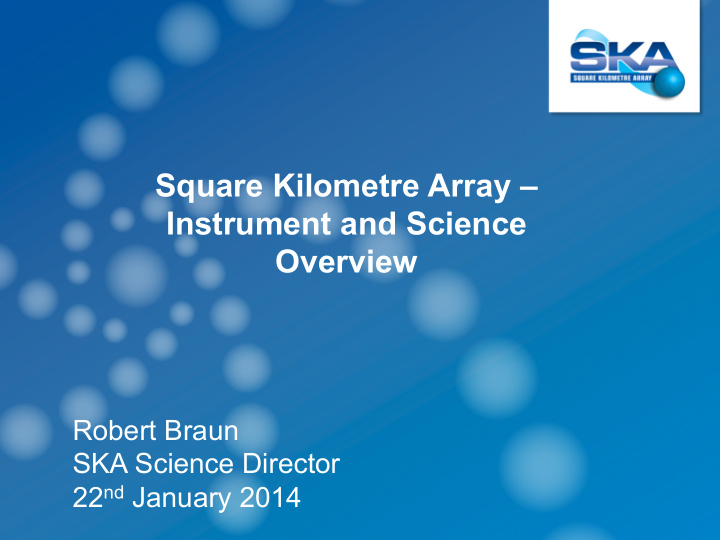



Square Kilometre Array – Instrument and Science Overview Robert Braun SKA Science Director 22 nd January 2014
Great Observatories for the coming decades E-ELT E-ELT optical/IR optical/IR Construction Constructio approved n approved
Great Observatories for the coming decades Atacama Large Millimetre Array (ALMA): mm/ submm Chajnantor Plateau @ 17,000 ft Early science now Inaugurated on 13 th March 2013
Great Observatories for the coming decades James Webb Space Telescope: due for launch in 2018
Great Observatories for the coming decades Square Kilometre Array: radio Construction start 2017/18
Specialised “experiments” EUCLID: ~ € 1B, launch 2020 LSST ~$750M, operational ~2020
Exploring the Universe with the world’s largest radio telescope Phase I : 2020 250,000 element Low Frequency Aperture Array 96 survey enabled dishes 254 dishes Phase II : 2024 >250,000 element Mid Frequency Aperture Low Frequency Aperture Array Array 2500 dishes Cosmic Dawn & Reionization Cosmology & Pulsars Cosmic Magnetism Cradle of Life Science Galaxy Evolution 50 MHz 100 MHz 1 GHz 10 GHz
Exploring the Universe with the world’s largest radio telescope Phase I : 2020 250,000 element Low Frequency Aperture Array 96 survey enabled dishes 254 dishes Phase II : 2024 >250,000 element Mid Frequency Aperture Low Frequency Aperture Array Array 2500 dishes Cosmic Dawn & Reionization Cosmology & Pulsars Cosmic Magnetism Cradle of Life Science Galaxy Evolution 50 MHz 100 MHz 1 GHz 10 GHz
How did we choose the site?
How did we choose the site?
Karoo Radio Astronomy Reserve 500 km 11
Murchison Radio Astronomy Observatory ; size of the Netherlands => 0.002 km -2
The Science Working Groups • Astrobiology (“The Cradle of Life”) – Project Scientist: Tyler Bourke – Working Group Chair: Melvin Hoare • Galaxy Evolution – Continuum – Project Scientist : Jeff Wagg – Working Group Chairs: Nick Seymour & Isabella Prandoni • Cosmic Magnetism – Project Scientist: Jimi Green – Working Group Chairs: Melanie Johnston-Hollitt & Federica Govoni • Cosmology – Project Scientist: Jeff Wagg – Working Group Chair: Roy Maartens • Epoch of Reionisation & the Cosmic Dawn – Project Scientist: Jeff Wagg – Working Group Chair: Leon Koopmans • Galaxy Evolution – HI – Project Scientist: Jimi Green – Working Group Chairs: Lister Staveley-Smith & Tom Osterloo • Pulsars (“Strong field tests of gravity”) – Project Scientist: Jimi Green – Working Group Chairs: Ben Stappers & Michael Kramer • Transients – Project Scientist: Tyler Bourke – Working Group Chair: Rob Fender
The Work Package Consortia Project Scientist: Jimi Green Project Scientists: Jeff Wagg & Tyler Bourke Project Scientist: Tyler Bourke Project Scientist: Jeff Wagg Project Scientists: Jimi Green & Tyler Bourke Project Scientist: Jimi Green Project Scientist: Jimi Green Project Scientist: Tyler Bourke Project Scientist: Tyler Bourke Project Scientist: Tyler Bourke Project Scientists: Jeff Wagg & Tyler Bourke
How does SKA1 baseline redefine state-of-art? SKA1, SKA1, LOFAR, SKA1, JVLA MeerKAT ASKAP mid survey NL low Aeff/Tsys 265 321 1630 65 391 61 1000 m2/K Survey>FoV 0.14 0.48 0.39 30 18 6 6 deg2 Survey>Speed> deg21m41 4 4 6 5 6 4 6 0.98×10 5.0×10 1.0×10 1.3×10 2.8×10 2.2×10 6.0×10 FoM K22 Resolution 1.4 11 0.22 7 0.9 5 11 arcsec A eff /T sys: 6xJVLA 6xASKAP 16xLOFAR 100x Survey Speed: 22xASKAP 270x 280xJVLA
Sensitivity comparison
Survey speed comparison
SKA1: facility versus “experiment” • Configura)on ¡op)misa)on ¡for ¡broad ¡performance ¡“sweet-‑spot” ¡
Recommend
More recommend